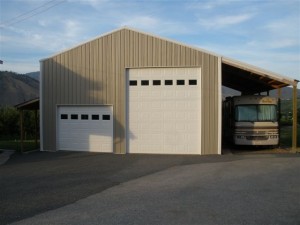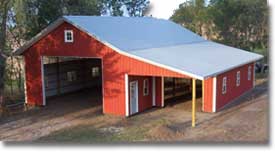Steel wrapped poles
Hansen Pole Buildings Designer Alan came up with a new client concern recently.
 His client lost his last barn to a fire, so the client’s idea for his new pole barn is to wrap the poles with light gauge steel, in order to keep them from burning. Of course Alan and I both came up with the same solution – at the same time – sprinkler system. The solid wood timber columns, are one of the last things which are going to burn through in a post frame building. Long before they fail, the roof system will have collapsed.
His client lost his last barn to a fire, so the client’s idea for his new pole barn is to wrap the poles with light gauge steel, in order to keep them from burning. Of course Alan and I both came up with the same solution – at the same time – sprinkler system. The solid wood timber columns, are one of the last things which are going to burn through in a post frame building. Long before they fail, the roof system will have collapsed.
Pole buildings are not only attractive, but are also sustainable, economical and provide fast construction solutions. The assumption can be, because we use wood for fuel, it must therefore burn easily! Burn? Yes. Easily? Not so much. In reality, wood is selected as fuel because it burns slowly and at a predictable rate. These are the same qualities which make it a safe construction product in the event of fire and should give confidence in pole buildings, as a design solution.
The “charring rate” of a wood structure means the time needed for the wood to be burned through. This can be calculated to determine the safety of a building or how long it will take to burn and weaken its structural integrity. As a result of the thermal properties of wood, this can mean a timber will char on one side yet not even be warm just a fraction of an inch inside. These qualities contrast with the unpredictable nature of other structural products such as steel; which heat up more uniformly and give rise to expansion and loss of strength over the whole section, or masonry which cracks and starts to fall apart. Fire-fighters prefer to enter a burning building made of wood because they are better able to estimate how long they will be able to remain safely inside. Lumber will not fail dramatically like, for instance, reinforced concrete.
Even low density wood species will take 30 minutes to burn through an inch thickness, which will ensure the columns of a post frame building will retain structural integrity for over an hour of exposure to fire.
Still uneasy? Then consider putting a sprinkler system into your new wood framed building.
For more information click on this link to “read more about it”: https://www.hansenpolebuildings.com/blog/?s=sprinklers
 And…the envelope please….Whammy number three….hay storage inside of a barn with animals and farm equipment.
And…the envelope please….Whammy number three….hay storage inside of a barn with animals and farm equipment.





